和洋折衷の美しさとお香の香り(愛知県名古屋市千種区姫池通 骨董買取 古美術風光舎)
2023.09.10
皆さまこんにちは。スタッフHでございます。
昨晩久しぶりにエアコンを付けずに寝ました。外からの風が気持ちよく、いつもより熟睡できた気がします。しかしまだまだ油断せず暑さ対策を怠らないよう気を引き締めております。
先日友人宅を訪問した際、近所に茶室がある素敵な美術館があるよと教えてもらい、少し覗いてみました。桑山美術館という住宅街にひっそり佇む落ち着いた美術館でした。
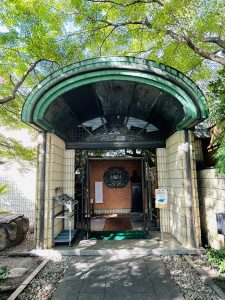
知多出身の実業家・桑山清一が永年に渡り収集した美術品/工芸品/茶道具を広く、多くの一般の方々に鑑賞してもらい、地域の文化向上に寄与することを願って設立された私設美術館です。
本館の外観は近代の洋館をイメージした現代建築といった趣きですが、庭は草庵茶室‘青山’を中心とした回遊式日本庭園で、この和洋折衷の雰囲気が何ともいえず居心地がいいのです。
茶室へ続く門の合間からも洋館がのぞいています。
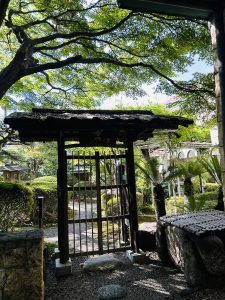
椿/桜/牡丹/つつじなど、春に見頃を迎える花が植えられ、紅葉も多いのできっと秋には見事な景色になるのでしょう。
茶室で印象的だったのは、腰掛待合から中門へかけての壁や庇(ひさし)のカーブ。壁は竹で覆われており、まるで西洋の神殿の柱にも見えました。やはりここも和洋折衷を意識しているのでしょうか。
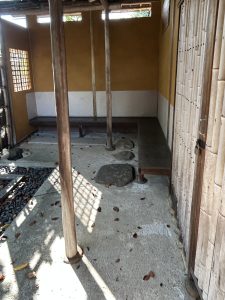
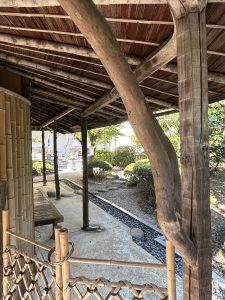
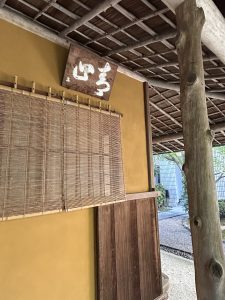
茶室内も障子を開けて拝見することができました。開けた途端、お香の良い香りがしました。
茶道では手前を行う前に香を焚いて空間を清めるとともに、香りをつけるためにお香を用います。
正式な茶席ではお茶を点てる前に炉や風炉に炭をくべる「炭点前」が行われますが、この炭点前の時に香を焚きます。現在の茶席では炭点前が省略されることも多く、茶室にて床の間を拝見した際に香合が飾られている場合「炭点前を省略します。」という意味になるそうです。
炭に乗せる前の香木などを入れている容器が香合ですが、茶道具のなかで種類が豊富で、その形状や素材は多岐にわたります。
炭点前の際のお香について知らないことが多かったので調べてみました。
お香にはいくつも種類があり、直接火をつけるタイプのお香が一般的に親しまれていますが、茶道では火を付けず熱灰の上に置き間接的に熱を加えることで茶室にやわらかな香りをそえてお客様をお迎えします。
使用するお香の種類は炉と風炉の季節により異なります。それに伴い「香合」も使い分けるそうです。
5月から10月の風炉の季節は「白檀」や「沈香」などの香木を使用します。風炉の季節は木地製や漆器の香合を用います。
11月から4月の炉の季節は練香(ねりこう)を使用します。練香とは粉末にした香料に密や梅肉を加えて練り上げ、一定期間熟成させた丸い形状のお香です。練香は配合により香りが様々に変化するので、亭主の好みの香りを用いるようです。練香を入れるため、炉の季節は陶磁器・焼物の香合を用います。
貝類や金属製の香合は時期を選ばず使用できるとのこと。
香合を床の間に飾る時には下には紙釜敷を20~30枚ほど重ね四つ折りにしたものを敷きます。紅白・染紙・美濃紙など種類が豊富にあり、亭主は香合との組み合わせにより季節感や茶席にのテーマに合わせ趣向をこらします。
茶事の世界はトータルコーディネートに抜かりがないですね。
秋になり、涼しくなったら久しぶりに体験したくなりました。
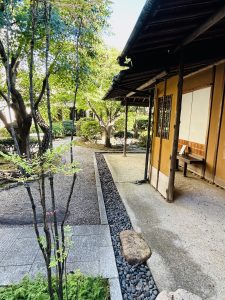
それでは、またお会いしましょう。
Hello everyone. This is Staff H.
Last night I slept without air conditioning for the first time in a while. The breeze from outside felt good, and I think I slept more soundly than usual. However, I am still trying to stay alert and take precautions against the heat.
When I visited a friend’s house the other day, she told me about a nice art museum with a tea ceremony room in the neighborhood, so I took a peek. I took a quick peek at the Kuwayama Museum of Art, a quiet art museum tucked away in a residential area.
It is a private art museum established by Seiichi Kuwayama, a businessman from Chita, in the hope that the art, crafts, and tea ceremony utensils he collected over the years will be widely appreciated by the general public and contribute to the cultural improvement of the area.
While the exterior of the main building is a modern Western-style building, the garden is a Japanese-style garden with a circular path around a hermitage teahouse called “Aoyama”.
The Western-style building peeks out from between the gates leading to the tea house.
The garden is planted with camellias, cherry blossoms, peonies, azaleas, and other flowers that are at their best in spring, and there are also many autumn leaves, so the scenery is sure to be spectacular in the fall.
What was impressive about the tea ceremony room was the curve of the wall and the eaves from the koshikake-waiting area to the middle gate. The walls were covered with bamboo and looked like the pillars of a Western temple. I wonder if the Japanese and Western style was also considered here.
We were also able to open the shoji to take a look inside the tea ceremony room. As soon as I opened the shoji, I could smell the fragrance of incense.
In the tea ceremony, incense is burned to purify the space and to add fragrance before the tea ceremony.
At formal tea ceremonies, before tea is served, charcoal is burned in a furnace or windmill, and incense is burned during this charcoal preparation. In today’s tea ceremony, charcoal preparation is often omitted. When you see the alcove in a tea room, if you see an incense container on display, it is said to mean “I will omit charcoal preparation.
The container that holds the fragrant wood before it is placed on the charcoal is called an incense container, and there are many types of incense containers among tea ceremony utensils, with a wide range of shapes and materials.
There are many different types of incense for charcoal preparation, so I did some research on this topic.
There are many types of incense, and while incense that is lit directly is generally popular, in the tea ceremony, incense is placed on hot ashes and heated indirectly to add a soft fragrance to the tea room and welcome guests.
The type of incense used depends on the season of the furnace and the wind furnace. The type of incense used depends on the season of the furnace and the fuso, and the “incense container” is used accordingly.
During the wind furnace season from May to October, incense wood such as sandalwood and agarwood is used. During the wind-burner season, wooden or lacquer incense containers are used.
During the furnace season from November to April, neriko (kneaded incense) is used. Neriko is a round form of incense that is made by kneading powdered fragrance with densely packed aroma powder or plum paste and allowing it to mature for a certain period of time. The fragrance of kneaded incense varies depending on the combination, so the owner of the house is likely to use the fragrance of his/her choice. In order to hold the kneaded incense, ceramic or pottery incense containers are used during the furnace season.
Shell or metal incense containers can be used regardless of the season.
Underneath the incense container, 20 to 30 sheets of paper kamashiki, folded four times, are placed. There are a wide variety of paper mats, such as red and white, dyed paper, and Mino paper, etc. The owner of the tea ceremony can choose the combination of the paper mat and the incense container to match the season and the theme of the tea ceremony.
The world of tea ceremonies is all about total coordination.
I would like to experience this for the first time in a long time when the weather turns cooler in the fall.
I hope to see you again soon.
*******************
ご実家の整理やお片付けなどをされている方のご相談などが多くございます。
お片付けなどくれぐれもご無理のないようになさってくださいませ。
風光舎では古美術品や骨董品の他にも絵画や宝石、趣味のお品など様々なジャンルのものを買受しております。
お片付けをされていて、こういうものでもいいのかしらと迷われているものでも、どうぞお気軽にご相談下さいませ。
また風光舎は、出張買取も強化しております。ご近所はもちろん、愛知県内、岐阜県、三重県その他の県へも出張いたします。
まずは、お電話お待ちしております。
愛知県名古屋市千種区姫池通
骨董 買取【古美術 風光舎 名古屋店】
TEL052(734)8444
10:00-17:00 OPEN
#出張買取#骨董#古美術#骨董品#絵画#版画#茶道具#刀剣#彫刻

